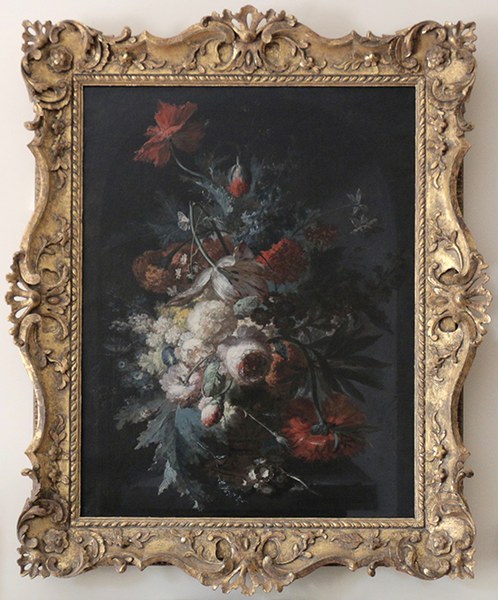This year marks the fiftieth anniversary of Mildred Barnes Bliss’s acquisition of a lesser-known but compelling painting in the House Collection: Still Life with Vase of Flowers by the Dutch master Jan van Huysum. Bliss purchased the painting from a Munich art dealer in 1965 to decorate the Rare Book Room, although today it hangs in the Director’s Office. The 1720 canvas—by one of the most successful and eccentric still life painters of his time—is thus not only an intriguing work in itself, but also a glimpse of Bliss’s original vision for her Garden Library.
Born in Amsterdam in 1682, van Huysum learned his trade from his father, an art dealer and skilled botanical painter. During his lifetime, his patrons included princes, dukes, and the kings of Prussia and Poland; the painting now at Dumbarton Oaks was once part of the collection of the earls of Derby. Arnold Houbraken, a biographer of Dutch artists, described van Huysum in 1718 as the “phoenix of flower-painters.” Van Huysum was reportedly jealous and secretive, refusing to admit even his own family to his studio in order to conceal his techniques for mixing colors and glazes.
The Dumbarton Oaks painting shows brightly illuminated flowers—primroses, poppies, peonies, morning glories, marigolds, and a tulip hanging from its broken stem—overflowing from an urn in a shadowed niche. A snail slides up one of the broad leaves at the bottom left, while a tiny white moth perches on the tulip stem. Van Huysum—who often spent his summers studying and sketching in Haarlem, a center for the cultivation of tulips and other plants—sought to illustrate with exactitude the texture and detail of the flowers. He also depicted plants that bloom in different seasons flowering in the same frame, rendering the image a beguiling mix of realism and fantasy. The broken tulip, the drooping poppy, and the fragile moth evoke the transience of earthly life. The painting thus combines aesthetic and scientific goals while also serving as a memento mori, a reminder to the viewer of his or her own mortality.
The synthesis of art, science, and philosophy that characterizes van Huysum’s still life reflects Bliss’s own conception of the Garden Library. As John S. Thacher, a former Director of Dumbarton Oaks, wrote in 1971, the Garden Library grew from Bliss’s “desire that the interests of scholarship at Dumbarton Oaks be extended to the field of garden design, giving full recognition to its place in the history of western culture.”
With advice from Beatrix Farrand, the designer of the Dumbarton Oaks Gardens, Bliss acquired the most important materials in the collection in the 1950s and left the library to Dumbarton Oaks upon her death in 1969. The Garden Library today houses over six thousand rare books, manuscripts, photographs, prints, and drawings related to the history of garden and landscape architecture. Like the painting that she chose to adorn its walls, Bliss’s Garden Library represents a space in which nature and culture are artfully and meaningfully intertwined.

